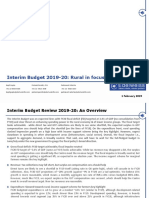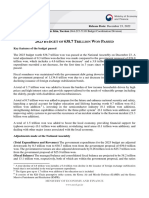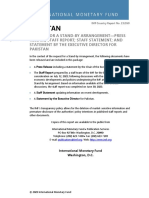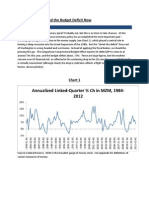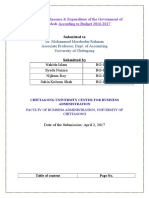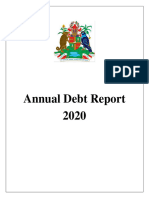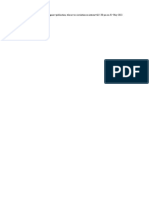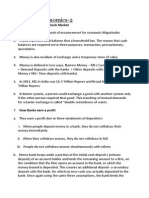Macroeconomic Framework of Union Budget 2021-22: Reconsidering The Fiscal Rules
Macroeconomic Framework of Union Budget 2021-22: Reconsidering The Fiscal Rules
Uploaded by
Arya SOriginal Description:
Original Title
Copyright
Available Formats
Share this document
Did you find this document useful?
Is this content inappropriate?
Report this DocumentCopyright:
Available Formats
Macroeconomic Framework of Union Budget 2021-22: Reconsidering The Fiscal Rules
Macroeconomic Framework of Union Budget 2021-22: Reconsidering The Fiscal Rules
Uploaded by
Arya SCopyright:
Available Formats
NIPFP Working paper series
Macroeconomic Framework of Union Budget
2021–22: Reconsidering the Fiscal Rules
No. 328
03-March-2021
Lekha Chakraborty
National Institute of Public Finance and Policy
New Delhi
Working Paper No. 328
Macroeconomic Framework of Union Budget 2021–22: Reconsidering
the Fiscal Rules
Lekha Chakraborty
Abstract
Extraordinary times require extraordinary policy responses. Against the backdrop
of macroeconomic uncertainty due to the CoVID-19 pandemic, the union finance minister
has announced a high fiscal deficit of 9.5% of gross domestic product (GDP) in revised
estimates (RE) 2020–21. This is against the pegged deficit of 3.5% in budget estimates
(BE) 2020–21. Simultaneously, the finance minister has also announced an excessive
deficit procedure to bring down the high fiscal deficit to 4.5% of the GDP by financial year
(FY) 2026. High deficit has no fiscal costs if it can be substantiated with increased public
investment or “output gap” reduction. When the monetary policy stance has limitations
in triggering growth through liquidity infusion and the status quo policy rates, “fiscal
dominance” is crucial for sustained growth recovery.
Thanks are due to Divy Rangan for research assistance. This paper was published in EPW
Budget Special 2021.
Accessed at https://www.nipfp.org.in/publications/working-papers/1925/ Page 2
Working Paper No. 328
Reconsidering Fiscal Rules
Globally, there is a fundamental rethinking about the efficacy of “fiscal rules”—
whether adhering to numeric threshold ratios of deficit is growth-enhancing. If the path
to fiscal consolidation is through expenditure compression rather than increased tax
buoyancy, the quality of fiscal consolidation gets affected. Chapter 2 of the Economic
Survey 2021 on public debt sustainability, highlights the perspective of the eminent
macroeconomist Olivier Blanchard (2019b: 1198) that “if the interest rate paid by the
government is less than the growth rate, then the intertemporal budget constraint facing
the government no longer binds.” From this perspective, as announced in the Union
Budget 2021, allowing a high fiscal deficit to GDP ratio to 9.5% of GDP in RE 2020–21 is
welcome.
In his presidential address to the American Economic Association (AEA),
Blanchard (2019a) explained that “public debt has no fiscal costs if real rate of interest is
not greater than real rate of growth of economy.” It was also highlighted that high public
debt is not catastrophic if “more debt” can be justified by clear benefits like public
investment or “output gap” reduction. His analysis highlighted the “hysteresis effects”—
the persistent impact of short-run fluctuations on the long-term potential output—and he
suggested that a temporary fiscal expansion during a contraction could even reduce debt
on a longer horizon. These perspectives are incorporated in the Economic Survey 2021
while analysing the debt–deficit dynamics.
The anatomy of the high fiscal deficit number announced in the Union Budget
2021 is relevant here. It is a combination of revenue shortfall, and new expenditure
priorities. Strengthening of “budget transparency” by incorporating prior off-budget
borrowings has also led to the rise in deficit number. The Food Corporation of India’s (FCI)
borrowing from the National Small Savings Fund (NSSF) is stopped, to bring in budget
transparency. When FY2021 fiscal deficit has reached 9.5%, the government envisions to
borrow another `80,000 crore in the next two months. For FY2022, the fiscal deficit is
pegged at 6.8% of GDP (Table 1).
The existing fiscal rules were amended to incorporate the revised threshold of
deficit to GDP. In the 2018 amendment to the Fiscal Responsibility and Budget
Management (FRBM) Rules 2004, the “golden rule” of zero revenue deficit was eliminated
and the clauses related to the elimination of “revenue balance” were incorporated in the
financial bill. However, in 2021–22 BE, revenue deficit is 5.1% of GDP. Though there was
a debate within the FRBM committee regarding the choice of deficit, whether revenue
deficit, fiscal deficit or primary deficit as the “operational deficit parameter” in India—
with Arvind Subramanian’s dissent note favouring the primary deficit (fiscal deficit minus
interest payments), the Union Budget 2021 reiterated that fiscal deficit is still the
operational concept of deficit in India. However, primary deficit is a useful concept to
understand the current fiscal stance of the government, without the legacy of interest
payments.
Accessed at https://www.nipfp.org.in/publications/working-papers/1925/ Page 3
Working Paper No. 328
Table 1: Levels of Deficit (Rs crores)
2019-20 2020-21 2020-21 2021-22
Actuals Budget Estimates Revised Estimates Budget Estimates
Fiscal Deficit 933651 796337 1848655 1506812
(4.6) (3.5) (9.5) (6.8)
Revenue Deficit 666545 609219 1455989 1140576
(3.3) (2.7) (7.5) (5.1)
Effective 480904 402719 1225613 921464
Revenue Deficit (2.4) (1.8) (6.3) (4.1)
Primary Deficit 321581 88134 1155755 697111
(1.6) (0.4) (5.9) (3.1)
Source: Government of India (2021), Union Budget documents
Extreme precaution is required when we measure “deficits” in the time of
pandemic. It may be incorrect to think that “cyclically neutral fiscal deficit” is a better
measure of deficit. It is important to analyse whether “disruptions” or “downturns” are
just “cyclical” and transitory; or whether it “permanently” leaves a scar and depresses the
level of output and employment. If it is a “drop” from the trend growth rather than a
“deviation,” it is incorrect to assume that an upturn in business cycle can eliminate the
“cyclical” part of deficit. Undoubtedly, such things cannot happen if there is no return of
the economic growth cycle to the prior trend growth path, and therefore this could mean
that the buoyancy of revenue receipts could remain below the prior-potential level.
In an economic downturn, if we are worried about a “bad equilibrium” of rising
debt and deficits, it is better to have a “contingent fiscal rule”; however, “keep the fiscal
rules, but do not use it” (Blanchard 2019a). In addition, Blanchard also argues against the
“steady” fiscal consolidation. Similarly, “a uniform and rigid fiscal rule not only
undermines the fiscal autonomy of the states, but would also result in ‘public
(developmental) expenditure compression’ to comply with numerical threshold ratio”
(Reddy and Reddy 2019: 74).
The sources of financing the fiscal deficit in the Union Budget 2012 show that
gross market borrowing (`12 lakh crore at 68.9% of total borrowings) is the dominant
financing mode. The NSSF constitutes around 26% of the total borrowings (Table 2, p 21).
The deficit incurred through off-budget borrowings through public sector enterprises can
be captured better through the construction of “Public Sector Borrowing Requirement”
(PSBR) data. However, the Union Budget 2021 has not introduced this new deficit concept
of PSBR. Instead, the details of such extra budget borrowings are still kept in an annexure
in the union budget document.
Accessed at https://www.nipfp.org.in/publications/working-papers/1925/ Page 4
Working Paper No. 328
Table 2: Sources of Financing Fiscal Deficit (Rs crores)
2019-20 2020-21 2020-21 2021-22
Actual % of Budget % of Revised % of Budget % of
Total Estimates Total Estimates Total Estimates Total
Debt Deficit (Net)
Market Borrowings 624089 66.84 535870 67.29 1273788 68.9 967708 64.22
(G-Sec + T Bills)
Securities against 240000 25.71 240000 30.14 480574 26 391927 26.01
Small Savings
State Provident 11635 1.25 18000 2.26 18000 0.97 20000 1.33
Funds
Other Receipts 44273 4.74 50848 6.39 39129 2.12 54280 3.6
(Internal Debt and
Public Account)
External Debt 8682 0.93 4622 0.58 54522 2.95 1514 0.1
Draw Down of Cash 4971 0.53 (-)53003 (-)6.66 (-)17358 (-)0.94 71383 4.74
Balance
Grand Total 933651 100 796337 100 1848655 100 1506812 100
Source: Government of India (2021), Union Budget documents
In the Union Budget 2021, creating fiscal space for an economic stimulus package
was a matter of concern. In a regime of revenue uncertainties, the Union Budget 2021
announced the asset monetisation programme, to generate revenue proceeds. The
revenue shortfalls of tax and non-tax revenue are significant (Table 3, p 21). The
disaggregate analysis shows that the fiscal slippage from the disinvestment proceeds is
the highest. In other words, the “fiscal marksmanship” ratio (BE to RE ratio) is highest for
disinvestment proceeds (last column of Table 3). Though asset sale is perceived as the
prominent source of fiscal proceeds, it constitutes only around 5% of the entire receipts
budget.
Accessed at https://www.nipfp.org.in/publications/working-papers/1925/ Page 5
Working Paper No. 328
Table 3: The Composition and Fiscal Marksmanship of Revenue Receipts
(In ₹ crore) In per cent
2019-20 2020-21 2020-21 2021-22 2019-20 2020- 2020- 2021- 2020-
21 21 22 21
Actuals Budget Revised Budget Actuals Budget Revised Budget Fiscal
Estimates Estimates Estimates Estimat Estimat Estimat marks
es es es mansh
ip/
fiscal
slippa
ge
REVENUE RECEIPTS
1. Tax Revenue
Gross Tax 2010059 2423020 1900280 2217059 74.96 78.28 54.80 64.98 1.28
Revenue
a. Corporation Tax 556876 681000 446000 547000 20.77 22.00 12.86 16.03 1.53
b. Taxes on Income 492654 638000 459000 561000 18.37 20.61 13.24 16.44 1.39
c. Wealth Tax 20 - - - 0.00
d. Customs 109283 138000 112000 136000 4.08 4.46 3.23 3.99 1.23
e. Union Excise 240615 267000 361000 335000 8.97 8.63 10.41 9.82 0.74
Duties
f. Service Tax 6029 1020 1400 1000 0.22 0.03 0.04 0.03 0.73
g. GST 598750 690500 515100 630000 22.33 22.31 14.85 18.47 1.34
- CGST 494072 580000 431000 530000 18.43 18.74 12.43 15.53 1.35
- IGST 9125 - - - 0.34
- GST 95553 110500 84100 100000 3.56 3.57 2.43 2.93 1.31
Compensation Cess
h. Taxes of Union 5835 7500 5780 7059 0.22 0.24 0.17 0.21 1.30
Territories
Less - NCCD 2480 2930 5820 6100 0.09 0.09 0.17 0.18 0.50
transferred to the
NCCF/NDRF
Less - State’s 650678 784181 549959 665563 24.27 25.34 15.86 19.51 1.43
share
1a Centre’s Net 1356902 1635909 1344501 1545397 50.60 52.85 38.77 45.29 1.22
Tax Revenue
2. Non-Tax 327157 385017 210653 243028 12.20 12.44 6.07 7.12 1.83
Revenue
Interest receipts 12349 11042 14005 11541 0.46 0.36 0.40 0.34 0.79
Dividends and 186132 155396 96544 103538 6.94 5.02 2.78 3.03 1.61
Profits
External Grants 373 812 1422 747 0.01 0.03 0.04 0.02 0.57
Other Non Tax 126540 215465 96602 124671 4.72 6.96 2.79 3.65 2.23
Revenue
Receipts of Union 1762 2303 2081 2531 0.07 0.07 0.06 0.07 1.11
Territories
Total- Revenue 1684059 2020926 1555153 1788424 62.81 65.29 44.85 52.42 1.30
Receipts (1a + 2)
0.00 0.00 0.00 0.00
Accessed at https://www.nipfp.org.in/publications/working-papers/1925/ Page 6
Working Paper No. 328
3. CAPITAL RECEIPTS 0.00 0.00 0.00 0.00
A. Non-debt 68620 224967 46497 188000 2.56 7.27 1.34 5.51 4.84
Receipts
(i) Recoveries of 18316 14967 14497 13000 0.68 0.48 0.42 0.38 1.03
loans and
advances@
(ii) Disinvestment 50304 210000 32000 175000 1.88 6.78 0.92 5.13 6.56
Receipts
B. Debt Receipts* 928680 849340 1866013 1435428 34.63 27.44 53.81 42.07 0.46
Total Capital 997301 1074306 1912510 1623428 37.19 34.71 55.15 47.58 0.56
Receipts (A+B)
4. Draw-Down of 4970 -53003 -17358 71383 0.19 -0.50 2.09
Cash Balance
Total Receipts 2681360 3095233 3467663 3411853 100.00 100.00 100.00 100.00 0.89
(1a+2+3)
Source: Government of India (2021), (Basic Data), Union Budget documents
Economic Stimulus
The economic stimulus packages have two components. One focuses on measures
that relate to instantaneous economic firefighting and the other pertains to long-term
policy imperatives. On the monetary policy front, the Reserve Bank of India (RBI) has
done the heavy lifting through five consecutive lowering of the repo rate adding to a total
of 135 basis points from February to October 2019, along with liquidity infusion
programmes (Thomas and Chakraborty 2021). However, the monetary-fiscal linkages are
crucial to catalyse demand.
Stiglitz and Rashid (2020) pointed out that “today’s excess liquidity may carry a
high social cost. Beyond the usual fears about debt and inflation, there is also good reason
to worry that the excess cash in banks will be funneled toward financial speculation,” and
they warned that this could lead to a “climate of increased (economic) uncertainty” and
end up “discouraging both consumption and the investment needed to drive the
recovery.” This could lead us into a “liquidity trap” with a huge increase in the supply of
money and not much to show for use of it by businesses and households (Chakraborty
and Harikrishnan 2020).
In India, with a policy repo rate at 4%, the RBI has retained the status quo (RBI
2021). The Consumer Price Index (CPI) inflation, after crossing 7%, has led to a negative
rate of interest in India. However, the CPI inflation has cooled off to 4.6% in December
2020. The New Monetary Framework (NMF)—the agreement between the RBI and the
union government in February 2016 adopting inflation targeting—will be reviewed in
March 2021. When monetary policy stance has limitations, through its liquidity infusion
programmes and policy rate adjustments, in triggering growth, the fiscal dominance is
crucial for economic recovery. The economies which rebounded fast, ex post global
financial crisis, were the ones which resorted to significant fiscal stimulus.
In the Union Budget 2021, the fiscal stimulus was announced as “targeted”
economic packages, especially in capital infrastructure investment. There is an increasing
recognition of the fact that public investment has suffered from fiscal consolidation when
the national and subnational governments have over-adjusted to the fiscal rules by capital
expenditure compression. Empirical evidence suggest that public investment is one of the
Accessed at https://www.nipfp.org.in/publications/working-papers/1925/ Page 7
Working Paper No. 328
crucial determinants in strengthening private corporate investment in the context of
emerging economies (Vinod et al 2020). Intertemporally, there is no financial crowding
out through real interest rate mechanisms, as well (Chakraborty 2016).
The total size of the budget for FY2021 has increased to `34.50 lakh crore. In
FY2022, total expenditure is pegged at `35 lakh crore. Out of total spending by the central
government, 10% constitutes defence, while 23% constitutes interest payments (Table 4,
p 22). The food subsidy is 12.25% of total central government revenue expenditure in
2021 RE, as compared to only 3.80% in 2020 BE. In agriculture, education, energy, and
home affairs, the fiscal slippage numbers above one reveal that RE is less than BE.
Intertemporally, the budget credibility analysis of macro-fiscal variables at national and
subnational government levels revealed that the reasons for fiscal forecasting errors can
be bias, variation or random (Chakraborty et al 2020).
Table 4: Anatomy of Revenue Expenditure
(In ₹ crore) (in %)
2019-20 2020-21 2020-21 2021- 2019- 2020- 2020-21 2021- 2020-
22 20 21 22 21
BE/RE
Actuals Budget Revised Budget Actuals Budget Revised Budget Fiscal
Estimates Estimates Estimates Estimates Estimates Estimates Slippage
Pension 183955 210682 204393 189328 6.85 6.93 5.92 5.44 1.03
Defence 318665 323053 343822 347088 11.86 10.62 9.96 9.96 0.94
Subsidy - 0.00 0.00 0.00 0.00
Fertiliser 81124 71309 133947 79530 3.02 2.34 3.88 2.28 0.53
Food 108688 115570 422618 242836 4.05 3.80 12.25 6.97 0.27
Petroleum 38529 40915 38790 12995 1.43 1.34 1.12 0.37 1.05
Agriculture 112452 154775 145355 148301 4.19 5.09 4.21 4.26 1.06
and Allied
Activities
Commerce 27299 27227 23515 34623 1.02 0.89 0.68 0.99 1.16
and Industry
Development 2658 3049 1860 2658 0.10 0.10 0.05 0.08 1.64
of North East
Education 89437 99312 85089 93224 3.33 3.26 2.47 2.68 1.17
Energy 43542 42725 33440 42824 1.62 1.40 0.97 1.23 1.28
External 17246 17347 15000 18155 0.64 0.57 0.43 0.52 1.16
Affairs
Finance 18535 41829 50566 91916 0.69 1.37 1.47 2.64 0.83
Health 63425 67484 82445 74602 2.36 2.22 2.39 2.14 0.82
Home Affairs 119850 114387 98106 113521 4.46 3.76 2.84 3.26 1.17
Interest 612070 708203 692900 809701 22.78 23.28 20.08 23.25 1.02
IT and 20597 59349 32178 53108 0.77 1.95 0.93 1.52 1.84
Telecom
Others 79523 84256 94371 87528 2.96 2.77 2.74 2.51 0.89
Planning and 5479 6094 2164 2472 0.20 0.20 0.06 0.07 2.82
Statistics
Rural 142384 144817 216342 194633 5.30 4.76 6.27 5.59 0.67
Development
Accessed at https://www.nipfp.org.in/publications/working-papers/1925/ Page 8
Working Paper No. 328
Scientific 27367 30023 22352 30640 1.02 0.99 0.65 0.88 1.34
Departments
Social Welfare 44649 53876 39629 48460 1.66 1.77 1.15 1.39 1.36
Tax 169331 152962 147728 131100 6.30 5.03 4.28 3.76 1.04
Administratio
n
of which 153910 135368 106317 100000 5.73 4.45 3.08 2.87 1.27
Transfer to
GST
Compensation
Fund
Transfer to 148907 200447 207001 293302 5.54 6.59 6.00 8.42 0.97
States
Transport 153437 169637 218622 233083 5.71 5.58 6.34 6.69 0.78
Union 15128 52864 51282 53026 0.56 1.74 1.49 1.52 1.03
Territories
Urban 42054 50040 46791 54581 1.57 1.64 1.36 1.57 1.07
Development
Grand Total 2686330 3042230 3450305 348323 100.00 100.00 100.00 100.00 0.88
6
Source: Government of India (2021), (Basic Data), Union Budget documents
Intergovernmental Fiscal Transfers
The finance minister has announced a new centrally sponsored scheme (CSS) for
enhancing public health infrastructure—Prime Minister Atma Nirbhar Swasth Bharat
Yojana—with an outlay of `64,180 crore over the next six years. However, the finance
minister has also announced a plausible convergence of CSS, as recommended by the
Fifteenth Finance Commission report, which was tabled in Parliament on 1 February
2021. This transition in the structure of intergovernmental fiscal transfers from
conditional grants to formula-based (tax transfers) unconditional transfers (which is 41%
of tax pool as recommended by the Fifteenth Finance Commission) is welcome. The
unconditional transfers provide greater fiscal autonomy to state governments. The
disaggregate analysis also shows that there is no increased centralisation in the design of
fiscal transfers in India with conditional grants constituting only 22.96% (BE 2021–22)
of the total transfers in India.
As per the 2020–21 RE, the tax transfer share (41.86%), goods and services tax
(GST) compensation (8.39%), finance commission grants, including the local body grants
and revenue deficit grants (13.88%) and CSS (23.99%) are the significant components of
intergovernmental fiscal transfers to the states in India (Table 5, p 23). The remaining 4%
is the intergovernmental fiscal transfers to the union territories, including Delhi, Jammu
and Kashmir and Puducherry.
Accessed at https://www.nipfp.org.in/publications/working-papers/1925/ Page 9
Working Paper No. 328
Table 5: Intergovernmental Fiscal Transfers – Conditional and Unconditional
(In ₹ crore) (in per cent )
2019-20 2020-21 2021-22 2019-20 2020-21 2021-22
Actuals Revised Budget Actuals Revised Budget
Estimates Estimates Estimates Estimates
I. Devolution of States share in taxes 650678 549959 665563 56.80 41.86 47.93
II. Some Important Items of Transfer 53706 171873 90055 4.69 13.08 6.49
1. Assistance to States from NDRF 18889 10000 12391 1.65 0.76 0.89
2. Back to Back Loans to States in lieu of - 110208 - 8.39
GST Compensation Shortfall
3. Central Pool of Resources for North 380 200 405 0.03 0.02 0.03
Eastern Region and Sikkim
4. Externally Added Projects – Grants 2702 2500 3000 0.24 0.19 0.22
5. Externally Aided Projects – Loan 24668 32025 46750 2.15 2.44 3.37
6. Schemes of North East Council 323 224 221 0.03 0.02 0.02
7. Schemes under Provision to Article 2661 718 1119 0.23 0.05 0.08
275(1) of the Constitution
8. Special Assistance as Loan to States for - 12000 10000 0.91 0.72
Capital Expenditure
9. Special Assistance under the demand - 1624 3000 15000 0.14 0.23 1.08
Transfers to States
10. Special Central Assistance to 1115 290 - 0.10 0.02
Scheduled Castes under Demand -
Department of Social Justice
and Empowerment
11.Special Central Assistance to Tribal 1346 708 1170 0.12 0.05 0.08
Area under the Demand - Ministry of
Tribal Affairs
III. Finance Commission Grants 123710 182352 220843 10.80 13.88 15.91
1. Grant for local bodies - Urban Bodies 25098 25000 22114 2.19 1.90 1.59
2. Grant for local bodies - 59361 60750 44901 5.18 4.62 3.23
Rural Bodies
3. Grants for Health Sector - - 13192 0.95
4. Grants-in-Aid for SDRF 10938 22262 22184 0.95 1.69 1.60
5. Post Devolution Revenue Deficit 28314 74340 118452 2.47 5.66 8.53
Grants
IV. Total Transfer to States [Other than 289233 358789 363355 25.25 27.31 26.17
(I)+(II)+(III)]
1. Under Centrally Sponsored Schemes 275428 315238 318857 24.04 23.99 22.96
(Revenue)
2. Under Central Sector Schemes 12864 42374 43016 1.12 3.22 3.10
(Revenue)
3. Under Other Categories of Expenditure 927 1049 1259 0.08 0.08 0.09
(Revenue)
4. Capital Transfers 13 128 223 0.00 0.01 0.02
V. Total Transfer to Delhi, Puducherry and 28161 50963 48686 2.46 3.88 3.51
Jammu & Kashmir
1. Under Centrally Sponsored Schemes 3578 6583 8065 0.31 0.50 0.58
(Revenue)
2. Under Central Sector Schemes 218 1080 177 0.02 0.08 0.01
(Revenue)
3. Under Other Categories of Expenditure 24140 43301 40444 2.11 3.30 2.91
(Revenue)
4. Capital Transfers 225 - - 0.02
Total Transfer to States/UTs 1145487 1313937 1388502 100.00 100.00 100.00
Source: Government of India (2021), (Basic Data), Union Budget documents
Accessed at https://www.nipfp.org.in/publications/working-papers/1925/ Page 10
Working Paper No. 328
Conclusions
In the time of macroeconomic uncertainty, high fiscal deficit announced in Union
Budget 2021 can be growth-enhancing as it can catalyse public investment and reduce the
output gap. The adherence to fiscal rules at 3 % of fiscal deficit—GDP ratio would have
been detrimental to economic recovery, especially when the monetary policy stance has
limitations in triggering growth through the liquidity infusion and the status quo policy
rates. Hence, the “fiscal dominance” is crucial for sustained growth recovery.
Accessed at https://www.nipfp.org.in/publications/working-papers/1925/ Page 11
Working Paper No. 328
References
Blanchard, Olivier, (2019a). “Public Debt and Low Interest Rates,” Presidential Address,
American Economic Association, Atlanta, 4 January,
https://www.piie.com/commentary/speeches-papers/public-debt-and-low-inte....
---------------, (2019b). “Public Debt and Low Interest Rates,” American Economic Review,
Vol 109, No 4, pp 1197–1229.
Chakraborty, Lekha and Amandeep Kaur (2020): “Why Output Gap Is Controversial?”
Financial Express, 23 December, https://www.financialexpress.com/opinion/why-
is-output-gap-controversial.
Chakraborty, Lekha and S Harikrishnan (2020). “The Reserve Bank’s Pandemic
Predicament,” Multiplier Effect, The Levy Economics Institute Blog, 24
June, https://multiplier-effect.org/the-reserve-banks-pandemic-predicament/.
Chakraborty, Lekha (2016). Fiscal Consolidation, Budget Deficits and the Macroeconomy,
New Delhi: Sage Publications.
Chakraborty, Lekha et al (2020). “Budget Credibility of Subnational Governments:
Analysing the Fiscal Forecasting Errors of 28 States in India,” Working Paper 964,
The Levy Economics Institute, New York.
GoI (2021). “The Economic Survey 2021–22,” Ministry of Finance, New Delhi.
-----------, (2021). “The Union Budget Documents 2021,” Ministry of Finance, New Delhi.
RBI (2021). “Monetary Policy Statement, 2020–21: Resolution of the Monetary Policy
Committee (MPC), 3–5 February 2021,” Press Release, 5 February 2021, Reserve
Bank of India, Mumbai,
https://rbidocs.rbi.org.in/rdocs/PressRelease/PDFs/PR105055BEF93017054F9.
Reddy, Y V and G R Reddy (2019). Indian Fiscal Federalism, New Delh: Oxford University
Press.
Stiglitz Joseph and Hamid Rashid (2020). “Which Economic Stimulus Works?” Project
Syndicate, 8 June, https://www.project-syndicate.org/commentary/stimulus-
policies-must-bene...? barrier=accesspaylog.
Thomas, Emmanuel and Lekha Chakraborty (2021). “Keep the Wheels of Economic
Recovery Turning,” Hindu, 28
January, https://www.thehindu.com/opinion/lead/keep-the-wheels-of-economic-
recove..
Vinod, H, H Karun and L Chakraborty (2020): “Encouraging Private Corporate Investment
in India,” Handbook of Statistics, H Vinod and C R Rao (eds), Chapter 5, Financial,
Macro and Micro Econometrics Using R, Vol 42, North Holland: Elsevier, pp 155–
83, https://www.elsevier.com/books/financial-macro-and-micro-econometrics-
us..
Accessed at https://www.nipfp.org.in/publications/working-papers/1925/ Page 12
MORE IN THE SERIES
Mukherjee, S., (2020). Pandemic and Lekha Chakraborty, Professor, NIPFP
GST Revenue: An Assessment for Email: [email protected]
Union and States, WP No. 327
(December).
Badola, S., and Mukherjee, S., (2020).
Factors Influencing Access to Formal
Credit of Unincorporated
Enterprises in India: Analysis of
NSSO’s Unit-level Data, WP No.
326 (December).
Patnaik. I., and Pandey, R., (2020).
Four years of the inflation targeting
framework, WP No. 325
(November).
National Institute of Public Finance and Policy,
18/2, Satsang Vihar Marg,
Special Institutional Area (Near JNU),
New Delhi 110067
Tel. No. 26569303, 26569780, 26569784
Fax: 91-11-26852548
www.nipfp.org.in
You might also like
- 3 Budget in Brief English 2022 23Document57 pages3 Budget in Brief English 2022 23Khawaja Burhan100% (2)
- PB 2022 Briefing Book 1Document49 pagesPB 2022 Briefing Book 1stevennelson10Noch keine Bewertungen
- Accounting and Finance For ManagersDocument322 pagesAccounting and Finance For ManagersPrasanna Aravindan100% (6)
- Chapter 2 Macro SolutionDocument12 pagesChapter 2 Macro Solutionsaurabhsaurs100% (1)
- Dimensions of The Proposed 2024 NG Budget - FinalDocument25 pagesDimensions of The Proposed 2024 NG Budget - FinalNichole SimblanteNoch keine Bewertungen
- BB2023-01 Dimensions of The FY 2023 NG BudgetDocument34 pagesBB2023-01 Dimensions of The FY 2023 NG BudgetKHIEAN HARVEY CAYETANONoch keine Bewertungen
- SBI Securities Union Budget 2023-24Document12 pagesSBI Securities Union Budget 2023-24Ganesh LadNoch keine Bewertungen
- Budget Analysis - Fiscal Consolidation, But Capex Push Remains AliveDocument6 pagesBudget Analysis - Fiscal Consolidation, But Capex Push Remains AliveAmit GulveNoch keine Bewertungen
- UnionBudgetReview-Feb01 23Document13 pagesUnionBudgetReview-Feb01 23manoj shelarNoch keine Bewertungen
- Union Budget 2024-25Document28 pagesUnion Budget 2024-25wizard416ytNoch keine Bewertungen
- Echap02 Vol2Document35 pagesEchap02 Vol2siriNoch keine Bewertungen
- Budget 2022 23Document24 pagesBudget 2022 23SahilHoodaNoch keine Bewertungen
- Namibias National Budget 2023 - 24.pdf WebDocument12 pagesNamibias National Budget 2023 - 24.pdf WebAmogh KothariNoch keine Bewertungen
- 2021 Fiscal PerformanceDocument5 pages2021 Fiscal PerformanceFuaad DodooNoch keine Bewertungen
- Bb2023-02 Analysis of The Presidents Budget For The Fiscal Year 2024 1Document78 pagesBb2023-02 Analysis of The Presidents Budget For The Fiscal Year 2024 1ANTHONY BALDICANASNoch keine Bewertungen
- 2021 Fiscal Performance, Part 2Document5 pages2021 Fiscal Performance, Part 2Fuaad DodooNoch keine Bewertungen
- Budget 2021 22 Highlights CommentsDocument135 pagesBudget 2021 22 Highlights CommentsArsal GujjarNoch keine Bewertungen
- Fiscal Policy Paper FY 2020/21: Government of JamaicaDocument112 pagesFiscal Policy Paper FY 2020/21: Government of JamaicaMecheal ThomasNoch keine Bewertungen
- Fiscal Position in RBIDocument25 pagesFiscal Position in RBIRahul LalNoch keine Bewertungen
- India Fiscal Preview: 2021-22 Union BudgetDocument13 pagesIndia Fiscal Preview: 2021-22 Union BudgetKaushik BaidyaNoch keine Bewertungen
- Union Budget 2024-25 - Analysis by Client AssociatesDocument4 pagesUnion Budget 2024-25 - Analysis by Client AssociatesamisinghNoch keine Bewertungen
- LankaBangla Budget Analysis FY'18Document33 pagesLankaBangla Budget Analysis FY'18Ismail RimonNoch keine Bewertungen
- Union Budget FY12: Reasonable Under The CircumstancesDocument25 pagesUnion Budget FY12: Reasonable Under The CircumstancesNitesh SuranaNoch keine Bewertungen
- Budget Analysis 09Document33 pagesBudget Analysis 09Vikash Kumar AgrawalNoch keine Bewertungen
- Part 3 Fiscal Complacency - AmortizationDocument7 pagesPart 3 Fiscal Complacency - Amortizationmyjoyonline.comNoch keine Bewertungen
- Union Budget Analysis 2024-25Document15 pagesUnion Budget Analysis 2024-25i.bohraNoch keine Bewertungen
- IMF Executive Board Approves US$3 Billion Stand-By Arrangement For PakistanDocument5 pagesIMF Executive Board Approves US$3 Billion Stand-By Arrangement For PakistanNauman AkramNoch keine Bewertungen
- Malaysia Macro Update 268437Document21 pagesMalaysia Macro Update 268437Lim Chau LongNoch keine Bewertungen
- CBO Budget Outlook 2021-2031Document5 pagesCBO Budget Outlook 2021-2031Stephen LoiaconiNoch keine Bewertungen
- [9798400248511 - IMF Staff Country Reports] Volume 2023 (2023)_ Issue 260 (Jul 2023)_ Pakistan_ Request for a Stand-by Arrangement-Press Release; Staff Report; Staff Statement; and Statement by the Executive DiDocument121 pages[9798400248511 - IMF Staff Country Reports] Volume 2023 (2023)_ Issue 260 (Jul 2023)_ Pakistan_ Request for a Stand-by Arrangement-Press Release; Staff Report; Staff Statement; and Statement by the Executive DiCool Bros PKNoch keine Bewertungen
- Budget in Brief EnglishDocument57 pagesBudget in Brief EnglishMuhammad Irfan KhanNoch keine Bewertungen
- Interim Budget 2019-20 - EdelDocument19 pagesInterim Budget 2019-20 - EdelSheldon RodriguesNoch keine Bewertungen
- MOEF Press Release - 2023 Budget ProposalDocument7 pagesMOEF Press Release - 2023 Budget ProposalJACKNoch keine Bewertungen
- Eco PPT Group 7Document7 pagesEco PPT Group 7prathampropwebNoch keine Bewertungen
- Press Release: 2023 B 638.7 T W PDocument2 pagesPress Release: 2023 B 638.7 T W PElectra EVNoch keine Bewertungen
- Union Budget FY25 UpdateDocument9 pagesUnion Budget FY25 UpdateAshutosh SamantNoch keine Bewertungen
- PakistanDocument120 pagesPakistanAli RazaNoch keine Bewertungen
- 1ARMEA2022002Document69 pages1ARMEA2022002animertarchianNoch keine Bewertungen
- 1CRIEA2022001Document115 pages1CRIEA2022001anastasiabeauty1803Noch keine Bewertungen
- Chapter 4 Analysis of Components of Receipts and Expenditure of Report No 20 of 2018 Compliance of The Fiscal Responsibility andDocument10 pagesChapter 4 Analysis of Components of Receipts and Expenditure of Report No 20 of 2018 Compliance of The Fiscal Responsibility andanimeshtechnosNoch keine Bewertungen
- 002 Article A002 enDocument14 pages002 Article A002 enRandolf PadrèNoch keine Bewertungen
- ProjectDocument9 pagesProjectSoumyadeep DuttaNoch keine Bewertungen
- Cut Taxes and Expand The Budget Deficit NowDocument22 pagesCut Taxes and Expand The Budget Deficit Nowmichael1519Noch keine Bewertungen
- UnionBudget-Feb01 17Document10 pagesUnionBudget-Feb01 17Dharmendra B MistryNoch keine Bewertungen
- Fiscal Development Revenue Relish HighlightDocument37 pagesFiscal Development Revenue Relish Highlightsomesh reddyNoch keine Bewertungen
- The Pattern of Income & Expenditure of The Government of Bangladesh According To Budget 2016-2017Document8 pagesThe Pattern of Income & Expenditure of The Government of Bangladesh According To Budget 2016-2017Nahida IslamNoch keine Bewertungen
- LBSL Budget Analysis FY20Document27 pagesLBSL Budget Analysis FY20Imtiuz ShuvoNoch keine Bewertungen
- Union Budget 2023 24Document13 pagesUnion Budget 2023 24Thammineni YaswanthNoch keine Bewertungen
- People's Guide To SupplementaryDocument18 pagesPeople's Guide To SupplementaryGNoch keine Bewertungen
- CAG Report On State Government FinancesDocument36 pagesCAG Report On State Government Financesgorgeous1986Noch keine Bewertungen
- Abrar Karim ID-17206002 Budget EssayDocument4 pagesAbrar Karim ID-17206002 Budget EssayAbrarNoch keine Bewertungen
- Annual Budget Report 2020Document20 pagesAnnual Budget Report 2020L.E.A.D Holding LLCNoch keine Bewertungen
- NSHE Proposals To Comply W/ Additional $25 Million Budget CutDocument9 pagesNSHE Proposals To Comply W/ Additional $25 Million Budget CutJacob SolisNoch keine Bewertungen
- UnionBudgetPreview-Jan14 21Document13 pagesUnionBudgetPreview-Jan14 21Chirag prajapatiNoch keine Bewertungen
- Report On Estimated Receipts and DisbursementsDocument28 pagesReport On Estimated Receipts and DisbursementsCapitol PressroomNoch keine Bewertungen
- This Press Release Is Embargoed Against Publication, Telecast or Circulation On Internet Till 5.30 PM On 31 May 2022Document56 pagesThis Press Release Is Embargoed Against Publication, Telecast or Circulation On Internet Till 5.30 PM On 31 May 2022Parth BhatiaNoch keine Bewertungen
- 2024 - Budget-HighlightsDocument31 pages2024 - Budget-HighlightselgonzawebNoch keine Bewertungen
- Budget AltDocument28 pagesBudget AltFreelancerNoch keine Bewertungen
- Pakistan Crises Perfect StormDocument17 pagesPakistan Crises Perfect StormAbdul Moeed HasanNoch keine Bewertungen
- IDirect BudgetReview 2022-23Document13 pagesIDirect BudgetReview 2022-23Nagesha pa nagaNoch keine Bewertungen
- Eco SurDocument84 pagesEco Surshashi2002kant123Noch keine Bewertungen
- Strengthening Fiscal Decentralization in Nepal’s Transition to FederalismFrom EverandStrengthening Fiscal Decentralization in Nepal’s Transition to FederalismNoch keine Bewertungen
- 2016 Tax1 TSN Dean Quibod 1st ExamDocument35 pages2016 Tax1 TSN Dean Quibod 1st ExamJose Gerfel GeraldeNoch keine Bewertungen
- CH 09Document43 pagesCH 09Binar Arum NurmawatiNoch keine Bewertungen
- Map4c Skills 5 1 by P HannaDocument8 pagesMap4c Skills 5 1 by P Hannaapi-268810190Noch keine Bewertungen
- Accounting 9th Edition Horngren Solution ManualDocument19 pagesAccounting 9th Edition Horngren Solution ManualAsa100% (1)
- Vinod Pandey ProjectDocument128 pagesVinod Pandey ProjectHrithik GargNoch keine Bewertungen
- Martin Packing Company Case AnalysisDocument2 pagesMartin Packing Company Case AnalysisShambhawi SinhaNoch keine Bewertungen
- Circular FlowDocument10 pagesCircular FlowRosismita BaralNoch keine Bewertungen
- Budget Ch04 NewDocument17 pagesBudget Ch04 NewJoe OgleNoch keine Bewertungen
- Homework Solution - Week 11 - Chap 15Document2 pagesHomework Solution - Week 11 - Chap 15Gloria WongNoch keine Bewertungen
- Variations in Construction ContractsDocument20 pagesVariations in Construction Contractsahmedmushtaq041Noch keine Bewertungen
- Introduction To FinanceDocument31 pagesIntroduction To FinanceJean FlordelizNoch keine Bewertungen
- Rbi Grade BDocument2 pagesRbi Grade BNeeraj KumarNoch keine Bewertungen
- ICare First Preboard Examination-MSDocument14 pagesICare First Preboard Examination-MSLeo M. SalibioNoch keine Bewertungen
- Annex C-IPSAS ChecklistsDocument231 pagesAnnex C-IPSAS Checklistsshane natividadNoch keine Bewertungen
- Cost and Management AccountingDocument4 pagesCost and Management AccountingMsKhan0078Noch keine Bewertungen
- Financial Planning and Control A Key To Management Efficiency A Case Study of Nigeria Breweries Ninth Mile Corner EnuguDocument65 pagesFinancial Planning and Control A Key To Management Efficiency A Case Study of Nigeria Breweries Ninth Mile Corner Enuguchukwu solomon67% (3)
- 03-02-2020 - Handwritten NotesDocument19 pages03-02-2020 - Handwritten NotesRohini YadavNoch keine Bewertungen
- TVM NPVDocument86 pagesTVM NPVChristine Joy Guinhawa DalisayNoch keine Bewertungen
- Annex 10 - JPLGDocument50 pagesAnnex 10 - JPLGOmar AwaleNoch keine Bewertungen
- Final DGKCDocument10 pagesFinal DGKCAsad BumbiaNoch keine Bewertungen
- Notes in EconomicsDocument14 pagesNotes in EconomicsDeepak JanagarathinamNoch keine Bewertungen
- Fauquier County Public Schools Fiscal 2019 BudgetDocument384 pagesFauquier County Public Schools Fiscal 2019 BudgetLawrence EmersonNoch keine Bewertungen
- LGU-NGAS TableofContentsVol1Document6 pagesLGU-NGAS TableofContentsVol1Pee-Jay Inigo UlitaNoch keine Bewertungen
- Practice Examination Public AdministrationDocument3 pagesPractice Examination Public AdministrationRonald OngudaNoch keine Bewertungen
- 1.mankiw - ch10 (1) AD I - TDocument53 pages1.mankiw - ch10 (1) AD I - TFathimah KurniawatiNoch keine Bewertungen
- Mohamed Dahlan Ibrahim, PH.D Associate ProfessorDocument41 pagesMohamed Dahlan Ibrahim, PH.D Associate ProfessorYihhouTeeNoch keine Bewertungen
- 15 Budgeting - Profits, Sales, Costs - ExpensesDocument15 pages15 Budgeting - Profits, Sales, Costs - ExpensesVanity Claire Tiburcio100% (1)
- Budgeting WsDocument5 pagesBudgeting Wsapi-290878974Noch keine Bewertungen



















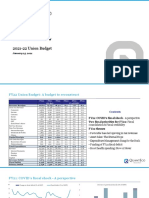




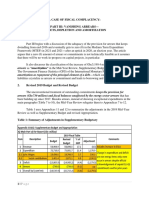




![[9798400248511 - IMF Staff Country Reports] Volume 2023 (2023)_ Issue 260 (Jul 2023)_ Pakistan_ Request for a Stand-by Arrangement-Press Release; Staff Report; Staff Statement; and Statement by the Executive Di](https://imgv2-2-f.scribdassets.com/img/document/700781292/149x198/1fc210251e/1710583708?v=1)

